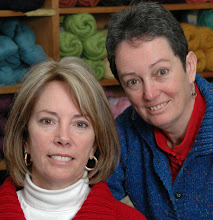GAUGE. Argghh. I know, it's a constant companion. Here's an excerpt from the YarnOver SleepOver Retreat booklet. I know knitting teachers do bang on about this!! Maybe this will help explain why it's so important.
MAKE IT FIT
Here is a common knitters lament: “I knit it exactly as the pattern said and it still didn’t turn out the right size”. Frustrating indeed. Did you check your gauge? Can I say the “S” word? Did you make a Swatch? A nice big one?
The reason many garments don’t fit when completed is because the knitter’s gauge did not match the pattern gauge. Garments are built on a certain size of stitch. Imagine each stitch as a little box. For example, let’s say your particular pattern calls for a stitch gauge of 20 sts = 4”/10cm. Break it down to 5 stitches = 1 inch.
Below are 5 boxes representing 5 stitches and 1” width, knit at different gauges. If you were knitting a 40” sweater you can see the difference gauge makes.
Do not despair. This can be fixed. I am also a knitter who does not usually knit to gauge. It’s perfectly normal.
Do’s & Don’t’s
Do Not try to change how you knit. Saying you’ll knit tighter or looser will last about 5 minutes!! Then you will be knitting in your normal manner. There is a better way.
Adjust your gauge by adjusting your needles.
· If the pattern calls for the gauge of 5 sts = 1” on a 4.5mm needle and you are getting 5½ sts = 1” then your stitches are a little smaller. You are getting more stitches in every inch. Bump your needle size up to 5.0mm and see if you are closer to the pattern gauge.
· If you are getting 4½ sts = 1” your stitches are a little big (fewer stitches in every inch). Try again with a 4.0mm needle which will make your stitches smaller.
Understanding if you are a tight knitter or a loose knitter helps you get started on adjusting your knitting for better fitting garments.







